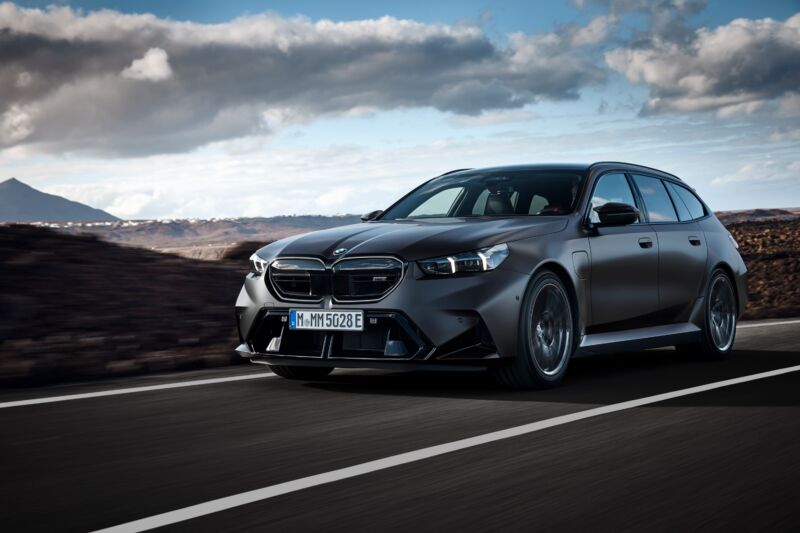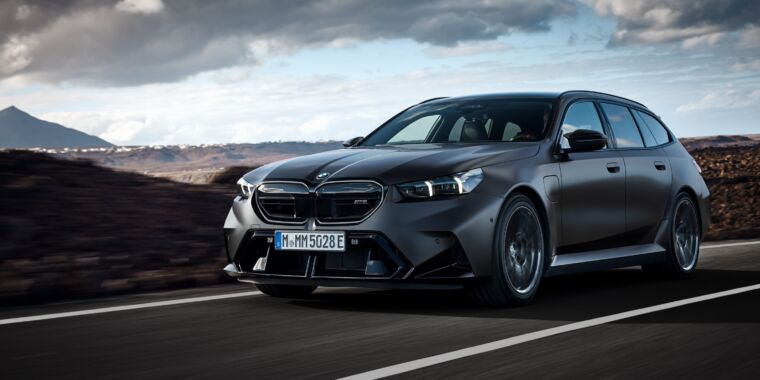
Fabian Kirchbauer Photography/BMW
Telling someone they can’t have something is a great way to make them want it. Take the station wagon, for example. This once-popular form factor for family transportation has all but disappeared from new-car showrooms across North America, making the wagon totally cool in the process. At the top of the heap are the superwagons, factory-tuned models with massive horsepower, one in particular of which has achieved legendary status, largely because BMW chose never to import the M5 Touring across the Atlantic. Until now.
BMW first made a Touring or estate version of the M5 in 1992 with the second generation (better known as the E34) 5 Series. Growing up in the UK, these were not available, nor were they in the US, so the five-door M5 quickly gained an extra cachet that the four-door lacked, despite a starring role in Ronin.
To be fair, the E34 M5 Touring looked really cool, but it wasn't a sales success.
The same could be said of the subsequent M5 Touring, which showed up in 2007 with the E61-generation 5 Series and a V10 under the hood. Only about 5 percent of E61 M5s were five-door wagons, and American customers were once again denied the opportunity to buy one. For the American M5 Touring fan, the answer seemed to be “wait until the 25-year rule comes into effect,” meaning that E34 M5 Tourings have been eligible for import for a few years now.
The M5 Touring skipped a generation, but BMW decided to bring it back for the latest iteration of its mid-size continent crusher. And while it looked for a moment as if the Touring would once again be a Euro-only thing, BMW’s North American arm has decided that the market is now ready for its most practical performance machines.
-
The shape of the two boxes looks so well proportioned as if it were a station wagon.
Fabian Kirchbauer Photography/BMW
-
The M5's launch in 2025 will take place towards the end of this year.
Fabian Kirchbauer Photography/BMW
-
Other colors than bright red are also available.
Fabian Kirchbauer Photography/BMW
-
The Touring is still extremely practical.
BMW
-
E34 M5 Touring are eligible for import under the 25-year rule.
BMW
-
The Touring body of the E61 generation looked the best.
BMW
People say it's too heavy
The G60-generation (or G61, for the Touring) M5 is a bit of a controversial car, however. It uses the same plug-in hybrid powertrain as the XM SUV, rated at 717 hp (535 kW) and 738 lb-ft (1,000 Nm) — more than double the power and torque of the E34 M5.
While there are clear advantages to a PHEV performance car, both in terms of performance (the electric motors deliver their torque directly) and efficiency (since it can drive on electric motors alone at low speeds), there is a slight drawback when it comes to weight. By adding a 14.8 kWh (usable) lithium-ion battery pack and the 194 hp (145 kW) electric motor, the M5 Touring’s curb weight is increased to 5,530 lbs (2,508 kg).
That's 1,683 lbs (763 kg) heavier than the first M5 Touring, and all that mass has driven enthusiasts nuts (though nearly every road test and first drive came back raving about the car's capabilities). And I'm pretty sure the 1992 M5 Touring didn't have heated and cooled seats, an infotainment system that could play video or games. And it definitely didn't have a torque-vectoring rear differential.
BMW debuted the U.S. version of the M5 Touring on Thursday as part of Monterey Car Week, and also announced pricing. If you want a car that can haul up to 57.6 cubic feet (1,632 L) of cargo and accelerate to 60 mph in 3.5 seconds, be prepared to pay BMW at least $122,675.

